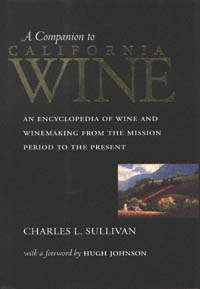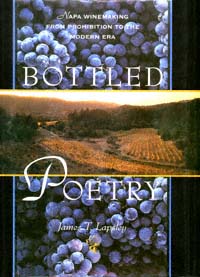formerly eScholarship Editions


|
|
|
|
Your search for
'Viticulture' in subject
found 2 book(s). | Modify Search | Displaying 1 - 2 of 2 book(s) | |
| 1. |  | Title: A companion to California wine: an encyclopedia of wine and winemaking from the mission period to the present Author: Sullivan, Charles L. (Charles Lewis) 1932- Published: University of California Press, 1998 Subjects: Viticulture | California and the West | Californian and Western History | Wine Publisher's Description: California is the nation's great vineyard, supplying grapes for most of the wine produced in the United States. The state is home to more than 700 wineries, and California's premier wines are recognized throughout the world. But until now there has been no comprehensive guide to California wine and winemaking. Charles L. Sullivan's A Companion to California Wine admirably fills that gap - here is the reference work for consumers, wine writers, producers, and scholars.Sullivan's encyclopedic handbook traces the Golden State's wine industry from its mission period and Gold Rush origins down to last year's planting and vintage statistics. All aspects of wine are included, and wine production from vine propagation to bottling is described in straightforward language. There are entries for some 750 wineries, both historical and contemporary; for more than 100 wine grape varieties, from Aleatico to Zinfandel; and for wine types from claret to vermouth - all given in a historical context.In the book's foreword the doyen of wine writers, Hugh Johnson, tells of his own forty-year appreciation of California wine and its history. "Charles Sullivan's Companion ," he adds, "will provide the grist for debate, speculation, and reminiscence from now on. With admirable dispassion he sets before us just what has happened in the plot so far." [brief] Similar Items |
| 2. |  | Title: Bottled poetry: Napa winemaking from Prohibition to the modern era Author: Lapsley, James T Published: University of California Press, 1997 Subjects: History | California and the West | United States History | Californian and Western History | Viticulture | Wine Publisher's Description: California's Napa Valley is one of the world's premier wine regions today, but this has not always been true. James Lapsley's entertaining history explains how a collective vision of excellence among winemakers and a keen sense of promotion transformed the region and its wines following the repeal of Prohibition. Focusing primarily on the formative years of Napa's fine winemaking, 1934 to 1967, Lapsley then concludes with a chapter on the wine boom of the 1970s, placing it in a social context and explaining the role of Napa vineyards in the beverage's growing popularity.Names familiar to wine drinkers occur throughout these pages - Beaulieu, Beringer, Charles Krug, Christian Brothers, Louis Martini, Inglenook - and the colorful stories behind the names give this book a personal dimension. These strong-willed, competitive winemakers found ways to work cooperatively, both in sharing knowledge and technology and in promoting their region. The result was an unprecedented improvement in wine quality that brought with it a new reputation for the Napa Valley.In The Silverado Squatters , Robert Louis Stevenson refers to wine as "bottled poetry," and although Stevenson's reference was to the elite vineyards of France, his words are appropriate for Napa wines today. Their success, as Lapsley makes clear, is due to much more than the beneficence of sun and soil. Craft, vision, and determination have played a part too, and for that, wine drinkers the world over are grateful. [brief] Similar Items |